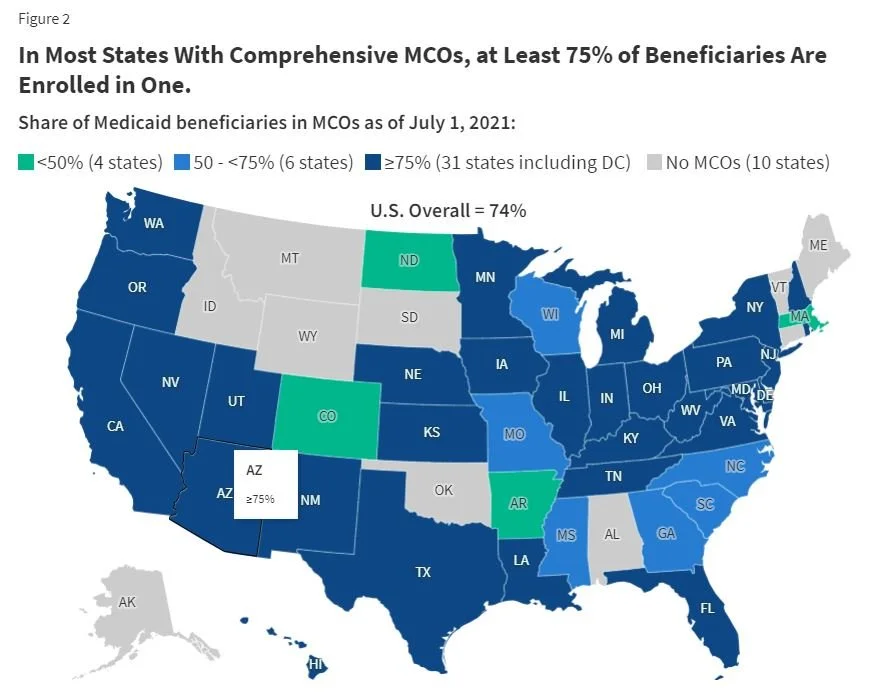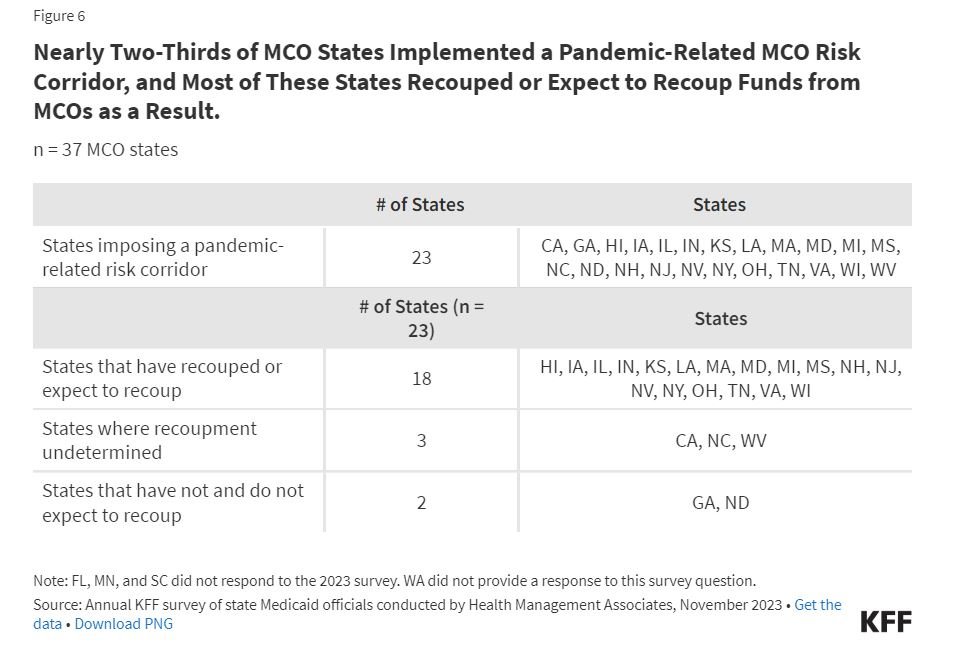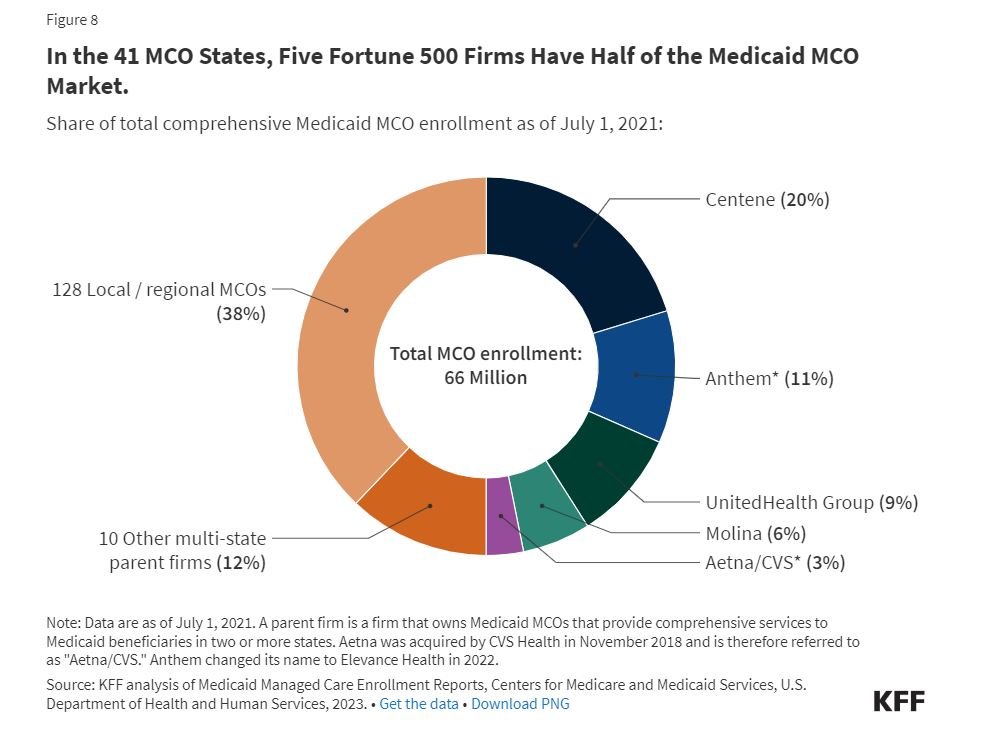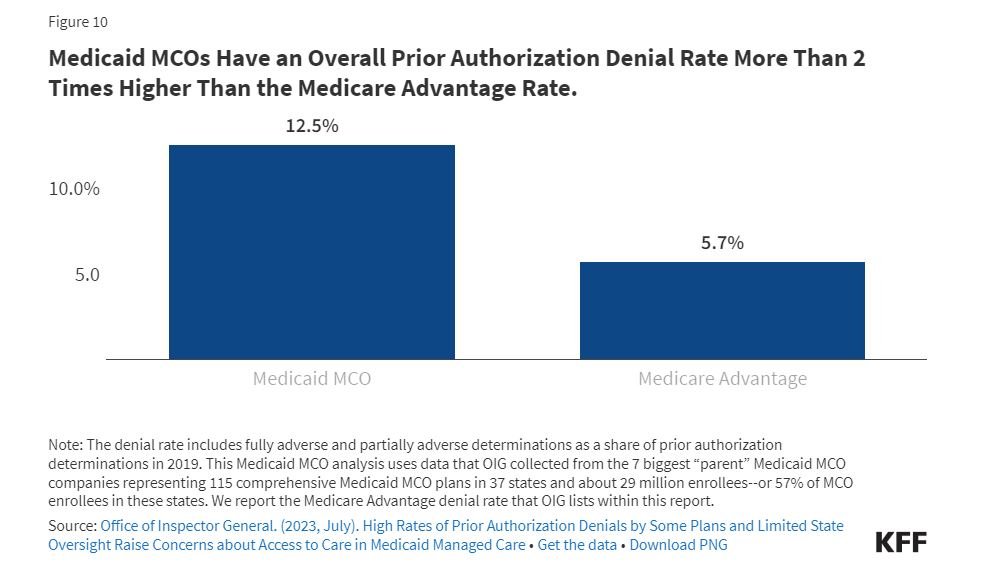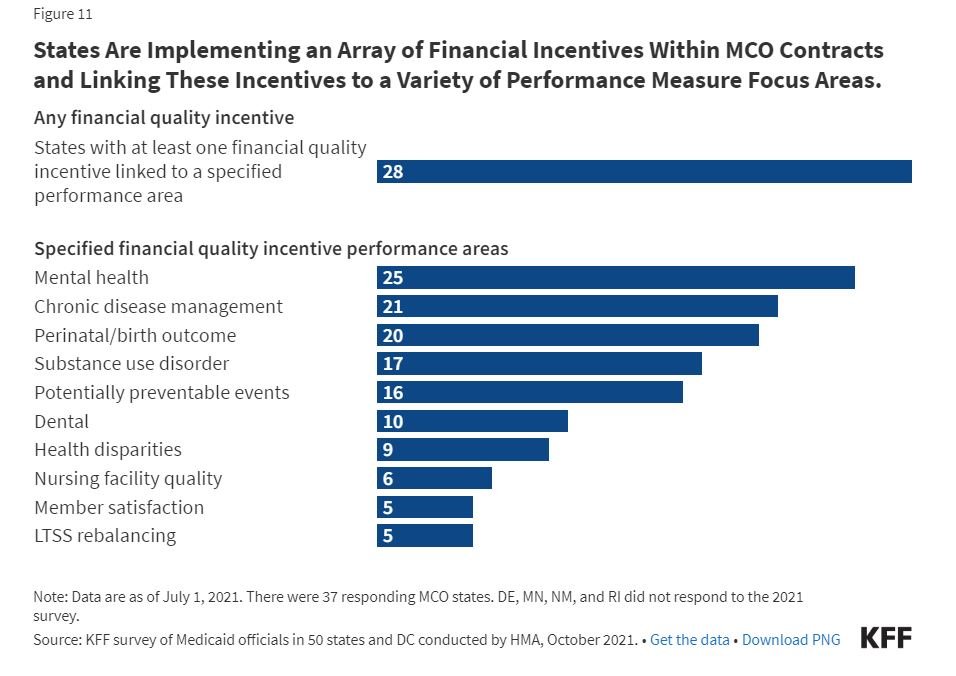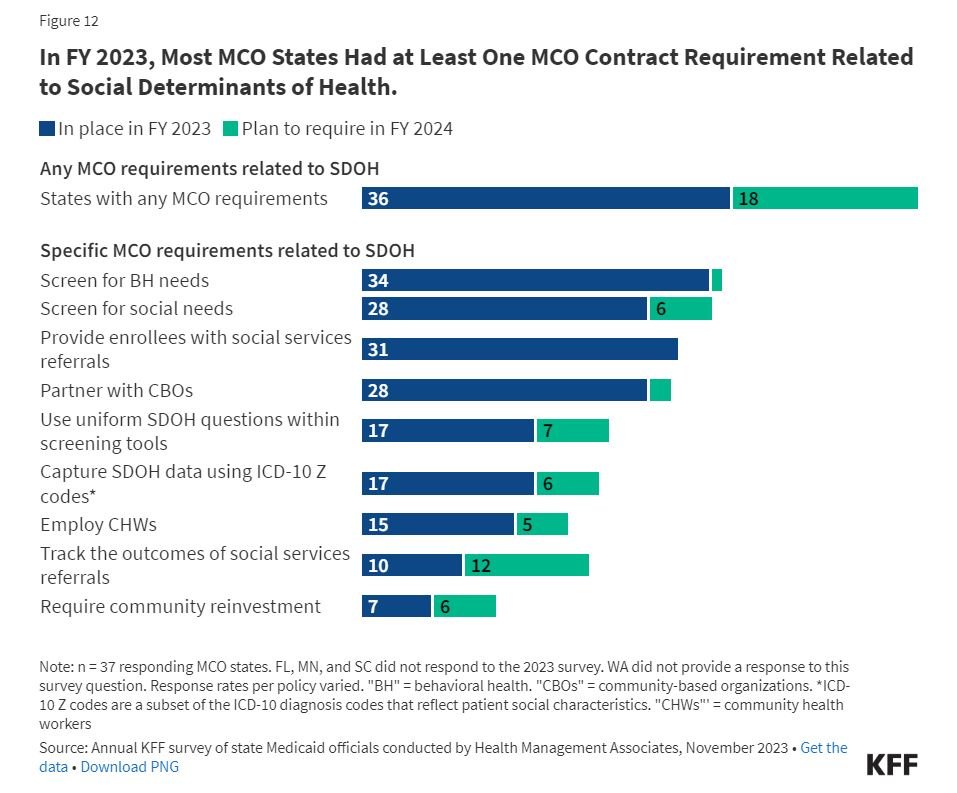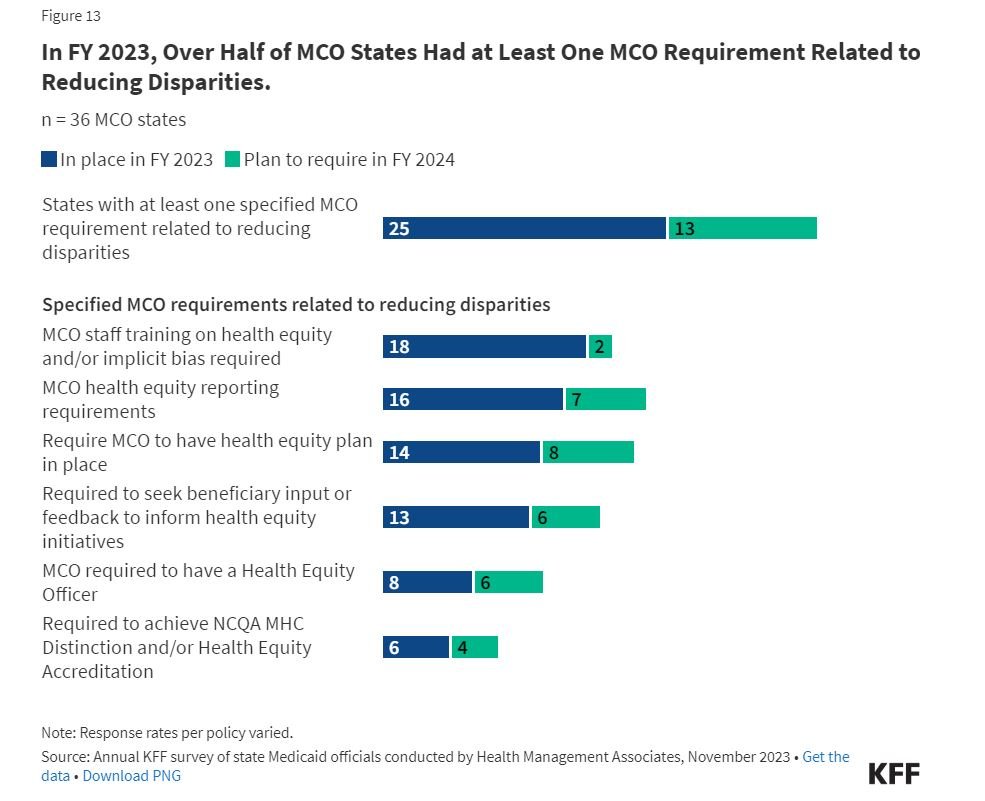10 Things to Know About Medicaid Managed Care
By Elizabeth Hinton and Jada Raphael / May 1, 2024
Managed care is the dominant delivery system for Medicaid enrollees. The latest national Medicaid managed care enrollment data (from 2021) show 74% of Medicaid beneficiaries were enrolled in comprehensive managed care organizations (MCOs). The Centers for Medicare and Medicaid Services (CMS) continues to highlight the role MCOs can play in helping people eligible for Medicaid use and keep their coverage during the unwinding of the continuous enrollment requirement. While managed care is the dominant Medicaid delivery system, states decide which populations and services to include in managed care arrangements, which leads to considerable variation across states. Additionally, while state requirements for Medicaid managed care plans can be tracked, plans have flexibility in certain areas, including in setting provider payment rates, and plans may choose to offer additional benefits beyond those required by the state. The Biden Administration released final regulations involving Medicaid Managed Care Access, Finance, and Quality in April 2024. While these rules are extensive and complex, a primary aim of the new rules is to strengthen standards for timely access to care and states’ monitoring and enforcement efforts. This brief describes 10 themes related to the use of comprehensive, risk-based managed care in the Medicaid program.
1. Today, capitated managed care is the dominant way in which states deliver services to Medicaid enrollees.
States design and administer their own Medicaid programs within federal rules. States determine how they will deliver and pay for care for Medicaid beneficiaries. Nearly all states have some form of managed care in place – comprehensive risk-based managed care and/or primary care case management (PCCM) programs.1,2 As of July 2023, 41 states (including DC) contract with comprehensive, risk-based managed care plans to provide care to at least some of their Medicaid beneficiaries (Figure 1). While not counted here, Oklahoma implemented capitated, comprehensive Medicaid managed care (for most children and adults) on April 1, 2024. Medicaid MCOs provide comprehensive acute care and, in some cases, long-term services and supports to Medicaid beneficiaries and are paid a set per member per month payment for these services. States have traditionally used managed care models to increase budget predictability, constrain Medicaid spending, and improve access to care and value. While the shift to MCOs has increased budget predictability for states, the evidence about the impact of managed care on access to care and costs is both limited and mixed.3,4,5
2. Nearly three-quarters (74%) of all Medicaid beneficiaries received their care through comprehensive risk-based MCOs.
As of July 2021, 66 million Medicaid enrollees received their care through risk-based MCOs. Thirty-one MCO states covered at least 75% of Medicaid beneficiaries in MCOs (Figure 2).
Although 2021 data (displayed above) are the most current national data available, enrollment in Medicaid overall grew substantially during the COVID public health emergency when states were prohibited from disenrolling people, resulting in growth in MCO enrollment as well. At the start of the “unwinding” period, in April 2023, Medicaid enrollment (overall) peaked at 94.5 million, an increase of 23 million or 32% from before the pandemic. As of December 2023, Medicaid enrollment declined by more than 9% across states, a decline of over 9 million people. CMS continues to highlight the role managed care plans can play in helping people eligible for Medicaid use and keep their coverage. Many strategies are available to states to minimize terminations for paperwork or procedural reasons, including temporary waivers that allow states to obtain updated enrollee contact information from MCOs, permit MCOs to assist enrollees in completing certain parts of renewal forms, and extend automatic reenrollment into an MCO plan from the standard 60 days up to 120 days.
3. Children and adults are more likely to be enrolled in MCOs than adults ages 65+ and people eligible through disability; however, states are increasingly including beneficiaries with complex needs in MCOs.
As of July 2022, 36 MCO states reported covering 75% or more of all children through MCOs (Figure 3). Of the 39 states that had implemented the ACA Medicaid expansion as of July 2022, 32 states were using MCOs to cover newly eligible adults and most covered more than 75% of beneficiaries in this group through MCOs. Thirty-five MCO states reported covering 75% or more of low-income adults in pre-ACA expansion groups (e.g., parents, pregnant women) through MCOs. Fewer MCO states reported coverage of 75% or more of adults ages 65+ and people eligible through disability. Although this group is still less likely to be enrolled in MCOs than children and adults, over time, states have been moving to include adults ages 65+ and people eligible through disability in MCOs.
4. In FY 2022, payments to comprehensive risk-based MCOs accounted for over half of Medicaid spending.
In FY 2022, state and federal spending on Medicaid services totaled over $804 billion. Payments made to MCOs accounted for about 52% of total Medicaid spending (Figure 4), unchanged from the previous fiscal year. The share of Medicaid spending on MCOs varies by state, but over three-quarters of MCO states directed at least 40% of total Medicaid dollars to payments to MCOs (Figure 5). State-to-state variation reflects many factors, including the proportion of the state Medicaid population enrolled in MCOs, the health profile of the Medicaid population, whether high-risk/high-cost beneficiaries (e.g., persons with disabilities, dual eligible beneficiaries) are included in or excluded from MCO enrollment, and whether or not long-term services and supports are included in MCO contracts. As states expand Medicaid managed care to include higher-need, higher-cost beneficiaries, expensive long-term services and supports, and adults newly eligible for Medicaid under the ACA, the share of Medicaid dollars going to MCOs could continue to increase.
5. Each year, states develop MCO capitation rates that must be actuarially sound and may include risk mitigation strategies.
States pay Medicaid managed care organizations a set per member per month payment for the Medicaid services specified in their contracts. Under federal law, payments to Medicaid MCOs must be actuarially sound. Actuarial soundness means that “the capitation rates are projected to provide for all reasonable, appropriate, and attainable costs that are required under the terms of the contract and for the operation of the managed care plan for the time period and the population covered under the terms of the contract.” Unlike fee-for-service (FFS), capitation provides upfront fixed payments to plans for expected utilization of covered services, administrative costs, and profit. Plan rates are usually set for a 12-month rating period and must be reviewed and approved by CMS each year. States may use a variety of mechanisms to adjust plan risk, incentivize plan performance, and ensure payments are not too high or too low, including risk sharing arrangements, risk and acuity adjustments, medical loss ratios (MLRs, which reflect the proportion of total capitation payments received by an MCO spent on clinical services and quality improvement), or incentive and withhold arrangements.
As pandemic-related enrollment increased, utilization decreased, and other cost and acuity changes began to emerge in 2020, CMS allowed states to modify managed care contracts, and many states implemented COVID-19 related “risk corridors” (where states and health plans agree to share profit or losses), allowing for the recoupment of funds. Nearly two-thirds of MCO states reported implementing a pandemic-related MCO risk corridor at any time since March 2020 (as of July 2023); more than three-quarters of these states (18 of 23) reported that recoupments for payments made for 2020, 2021, and/or 2022 had already occurred or were expected (Figure 6). Analysis of National Association of Insurance Commissioners (NAIC) data for the Medicaid managed care market show that average loss ratios in 2021 (in aggregate across plans) remained lower by three percentage points from 2019 (implying increased profitability). States and plans are now facing another period of heightened fiscal uncertainty due to the unwinding.
6. States make decisions about which services to carve in and out of MCO contracts.
Although MCOs provide comprehensive services to beneficiaries, states may carve specific services out of MCO contracts to fee-for-service systems or limited benefit plans. Services frequently carved out include behavioral health, pharmacy, dental, and long-term services and supports (LTSS). However, there has been significant movement across states to carve these services into MCO contracts. While the vast majority of states that contract with MCOs report that the pharmacy benefit is carved into managed care (32 of 41), eight states report that pharmacy benefits are carved out of MCO contracts as of July 2023 (Figure 7). As of April 1, 2023, New York carved the pharmacy benefit out of managed care, becoming the latest state to implement a full pharmacy carve-out.
7. Five publicly traded firms account for half of MCO enrollment.
States contracted with a total of 287 Medicaid MCOs as of July 2021. MCOs represent a mix of private for-profit, private non-profit, and government plans. As of July 2021, a total of 15 firms operated Medicaid MCOs in two or more states (called “parent” firms), and these firms accounted for 62% of enrollment in 2021 (Figure 8). Of the 15 parent firms, six are publicly traded, for-profit firms while the remaining nine are non-profit companies. Five firms – Centene, UnitedHealth Group, Anthem (renamed “Elevance” in 2022), Molina, and Aetna/CVS – account for 50% of all Medicaid MCO enrollment (Figure 8). All five are publicly traded companies ranked in the Fortune 500, and four are ranked in the top 100. Although Medicaid enrollment has declined across the five parent firms since the start of the unwinding, the three firms that report Medicaid-specific revenue information (UnitedHealth, Molina, and Centene) reported year-over-year (2023 over 2022) growth in Medicaid revenue (18%, 6%, and 3%, respectively). However, it is unclear what the revenue picture will look like at the end of the unwinding period.
8. In 2024, CMS finalized rules to strengthen access standards and to improve the prior authorization process.
In April 2024, CMS released final Managed Care rules aimed at strengthening access standards and state monitoring and enforcement. Historically, states have had broad flexibility to define network adequacy standards and to determine how to monitor and enforce MCO compliance with network adequacy standards and access requirements. Key provisions related to access in the new rule include:
Establishment of national maximum wait time standards for certain “routine” appointments (15 business days for primary care and OB/GYN services and 10 business days for outpatient mental health and substance use disorder services); sates must also establish an appointment wait time for a state-selected service (effective in 2027).
Requirement for states to conduct independent secret shopper surveys to validate compliance with wait time standards and the accuracy of provider directories (effective in 2028).
Requirement for states to conduct an annual enrollee experience survey for each managed care plan to ensure monitoring systems capture the enrollee experience (effective in 2027).
Requirement for states to submit an annual payment analysis comparing certain managed care provider rates to Medicare rates to better understand how payment rates may impact access (effective in 2026).
Requirement for states to implement remedy plans to address any areas where managed care plans need to make improvements to address access.
Requirements to support greater transparency, building on existing reporting requirements (e.g., Managed Care Annual Program Report and Network Adequacy Assurances Report) as well as identifying new state website requirements.
To help ensure provider participation, many states currently require minimum provider rates in their contracts with MCOs that may be tied to fee-for-service rates (or to Medicare rates or another fee schedule) (Figure 9). States that contract with managed care plans may also have uniform dollar or percentage increase payment requirements in place, most commonly for hospitals. These payment arrangements are known as “state directed payments.” The April 2024 final rules make a number of state directed payment policy changes, including establishing a payment rate ceiling at the average commercial rate for certain providers (including hospital and nursing facilities and for professional services provided at academic medical centers).
In January 2024, CMS finalized a rule focused on improving the prior authorization process including reducing approval wait times and improving transparency. A 2023 KFF survey of consumer experiences with health insurance found that about one in five Medicaid enrollees say they’ve had issues with prior authorization—higher than for most other types of insurance–and close to a quarter said that their health got worse because of this or another insurance problem. A July 2023 OIG report found that Medicaid MCOs had an overall prior authorization denial rate of 12.5%–more than 2 times higher than the Medicare Advantage rate (Figure 10), raising concerns about prior authorization and access in Medicaid managed care. OIG recommendations (to CMS) include strengthening state monitoring of denials. Recent MACPAC analysis of denials and appeals in Medicaid managed care resulted in the inclusion of seven recommendations in the March 2024 Report to Congress focused on improving the appeals process and enhancing monitoring and oversight of MCOs.
9. States are using an array of financial incentives linked to quality measures.
States incorporate quality metrics into the ongoing monitoring of their programs, including linking financial incentives like performance bonuses or penalties, capitation withholds, or value-based state-directed payments to quality measures. Over three quarters of MCO states reported using at least one financial incentive to promote quality of care as of July 2021 (Figure 11). Financial incentive performance areas most frequently targeted by MCO states include behavioral health, chronic disease management, and perinatal/birth outcomes. Despite activity in this area, detailed performance information at the plan-level frequently has not been made publicly available by state Medicaid agencies, limiting transparency and the ability of Medicaid beneficiaries (and other stakeholders) to assess how plans are performing on key indicators related to access, quality, etc.
States may use other non-financial methods to incentivize managed care plan performance including use of Quality Rating Systems (QRSs), which allow states and beneficiaries to compare performance across plans. In 2016, CMS issued regulations for the first time requiring that all states contracting with managed care plans adopt a CMS-developed quality rating system or an alternative state-developed QRS approved by CMS. The 2024 Managed Care final rule establishes the CMS framework and state requirements for the QRS, including mandatory measures for the quality ratings. While CMS is phasing in QRS requirements, states must make their QRS website publicly available by the end of 2028.
As part of managed care plan contract requirements, state Medicaid programs have also been focused on the use of alternative payment models (APMs) to reimburse providers and incentivize quality. Alternative payment models (APMs) replace FFS/volume-driven provider payments and lie along a continuum, ranging from arrangements that involve limited or no provider financial risk (e.g., pay-for-performance (P4P) models) to arrangements that place providers at more financial risk (e.g., shared savings/risk arrangements or global capitation payments). As of July 2021, about half of MCO states identified a specific target in their MCO contracts for the percentage of provider payments or plan members that MCOs must cover via APMs.
While there is some evidence of positive impacts from state use of financial incentives to engage managed care plans around quality and outcomes, the results are more mixed and limited at the provider level.6,7,8
10. States are looking to Medicaid MCOs to develop strategies to identify and address social determinants of health and to reduce health disparities.
Many states are leveraging MCO contracts to promote strategies to address social determinants of health and to improve health equity and reduce health disparities. The current Administration has identified advancing health equity as an important priority for the Medicaid program, including throughout its 2024 Managed Care final rule. In January 2023, CMS released guidance on the use of “in lieu of” services (ILOS) in Medicaid to reduce health disparities and address unmet health-related social needs (HRSN) (later codified in the April 2024 Managed Care rule). In December 2022, CMS announced a Section 1115 demonstration waiver opportunity to expand the tools available to states to address HRSN. In November 2023, CMS released a detailed Medicaid and CHIP HRSN Framework accompanied by an Informational Bulletin (CIB).
Most MCO states reported leveraging Medicaid MCO contracts to promote at least one strategy to address social determinants of health in FY 2023 (Figure 12). More than half of MCO states reported requiring MCOs to screen enrollees for behavioral health needs, provide referrals to social services, screen enrollees for social needs, and partner with community-based organizations (CBOs). Fewer states reported requiring MCO community reinvestment (i.e., directing plans to reinvest a portion of revenue or profits into the communities they serve) compared to other strategies.
States use an array of financial incentives to improve quality including linking performance bonuses or penalties, capitation withholds, or value-based state-directed payments to quality measures. About one-quarter of MCO states reported at least one MCO financial incentive tied to reducing racial/ethnic disparities in place in FY 2023. In addition to financial incentives, states can leverage managed care contracts in other ways to promote in other ways to promote reducing health disparities (Figure 13). In FY 2023, similar numbers of states (over one-third) reported requiring MCOs to train staff on health equity and/or implicit bias and meet health equity reporting requirements. States may also require MCOs to participate in Performance Improvement Projects (PIPs) focused on health disparities. In FY 2023, states reported a range of state-mandated PIP focus areas with an emphasis on reducing disparities including related to maternal and child health; chronic diseases; and substance use disorder (SUD).



